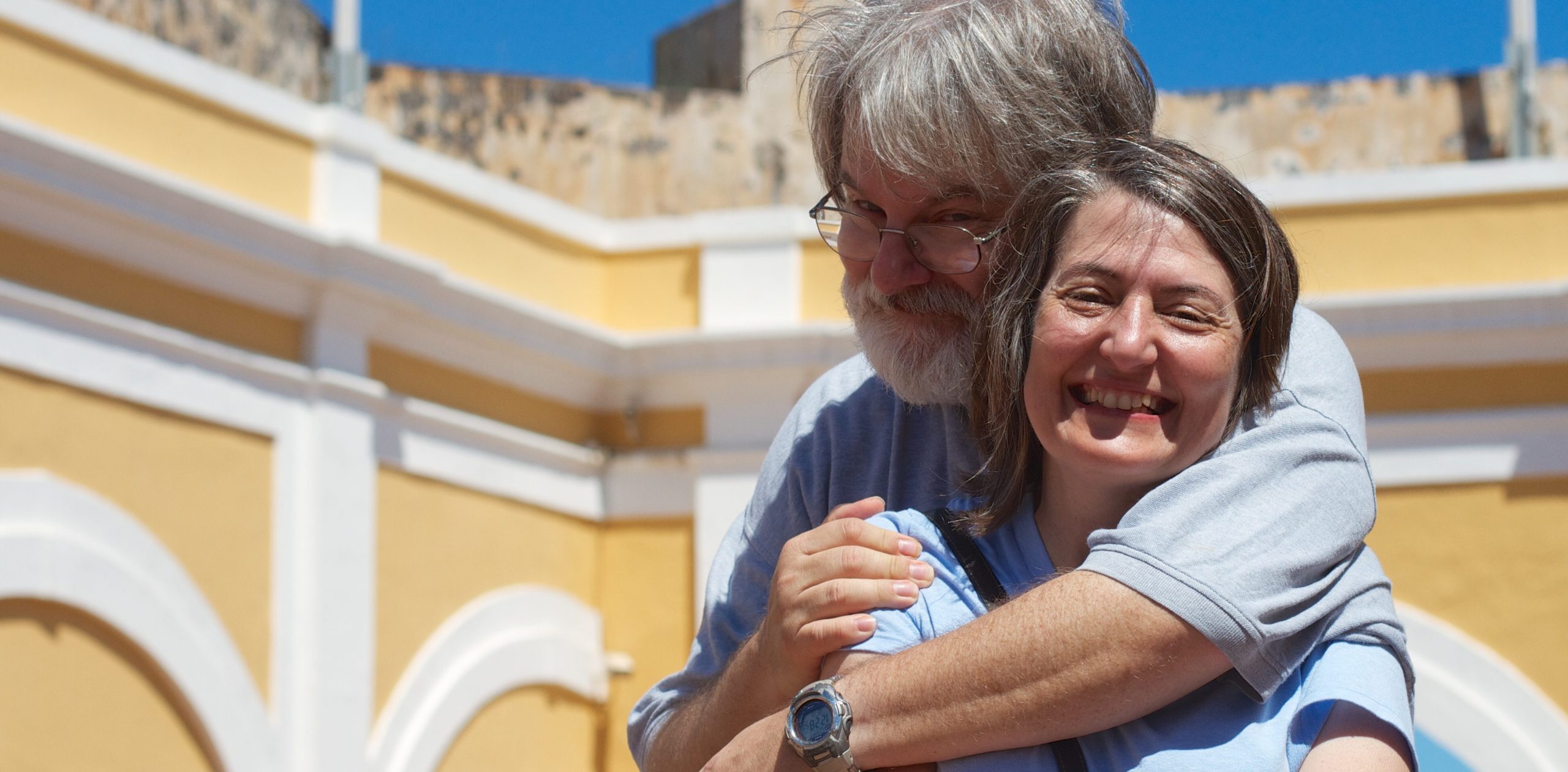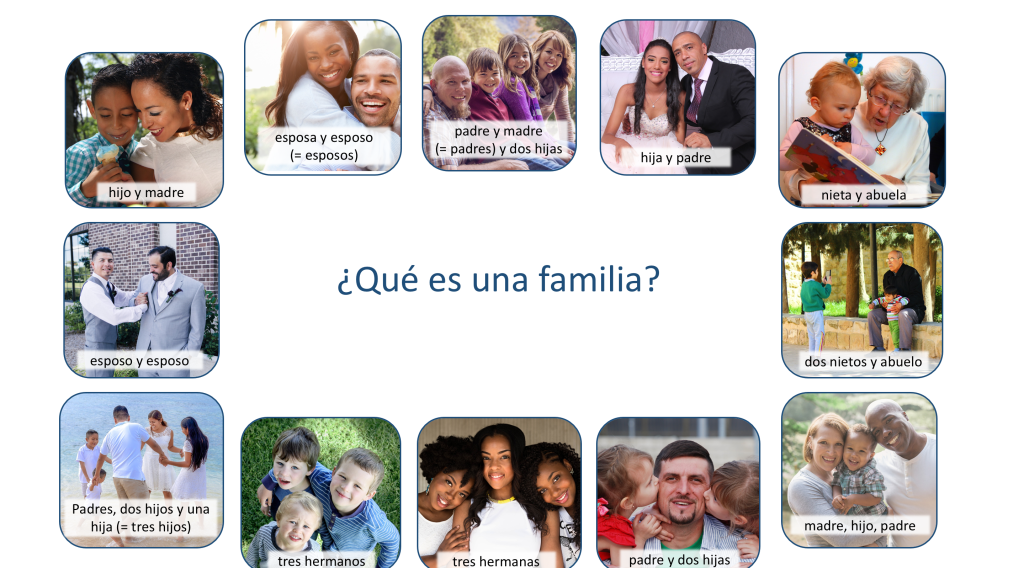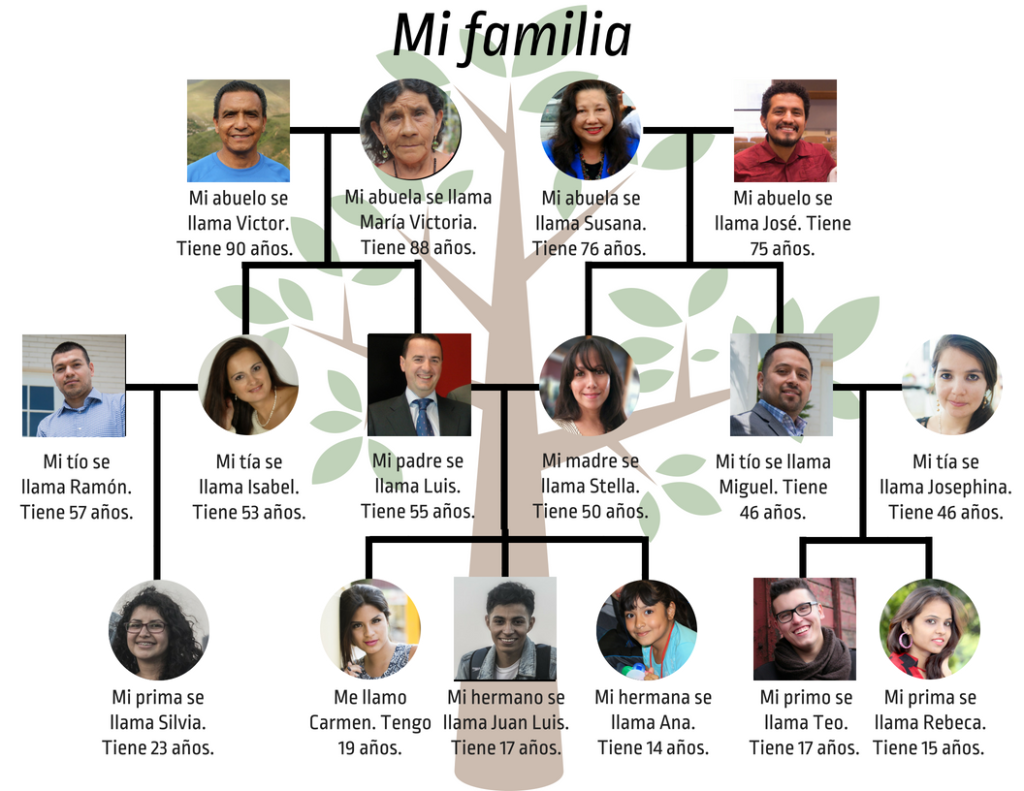

Mi familia
Entender el vocabulario y Personalizar la lección
Grammar—Expressing names
To say what someone’s name is in Spanish, use the verb “llamarse”. Do not add the word es, because “llamarse” really means “to call oneself”, not “my name is”.
Find five people in class who you don’t usually sit with. Ask them their names and tell them your own. Answer in complete sentences, as you see in this model:
- ¿Cómo te llamas?
- Me llamo [your name here].
| Llamarse = To call oneself | |
| yo me llamo | nosotros nos llamamos nosotras nos llamamos |
| tú te llamas | vosotros os llamáis vosotras os llamáis |
| él se llama ella se llama usted se llama |
ellos se llaman ellas se llaman ustedes se llaman |
Grammar—Expressing age
To express age in Spanish, we use tener + a number + años. You learned this verb in the last unit.
Ask five classmates how old they are and tell them your own age. You can ask your teacher, too. Answer in complete sentences, as you see in this model:
- ¿Cuántos años tienes? … or for your teacher, ¿Cuántos años tiene?
- Tengo [number or an adjective of quantity like varios, muchos, pocos] años.
Grammar—Indicating possession
Possessive adjectives (my, your, our, etc.) have equivalents in Spanish. Learn about them at the Spanish in Texas website. There is no ‘s in Spanish, so you can’t indicate possession that way. Instead, use de: la esposa de mi primo (the spouse of my cousin). If you have the word el after de, then you must make the contraction del: La amiga del profesor.
Mi familia
Draw a family tree—either of your own family or pretend that you’re a member of a famous family (real or fictitious). Label it with the family members’ names, their relationship to you, and how old they are. Use the family tree here as a model to help you.

La familia de Alejandro
Listen as Alejandro describes his family. Draw his family tree and label it with the names of the family members.
Intercambio—Mi familia y la familia de mi compañero o compañera
Before you can ask your partner the questions at the end of this page, you will need a new verb, vivir (to live). To learn how to conjugate verbs like vivir that end in -ir, watch Present Tense -ir Verbs.
Now sit with a classmate and ask him or her these questions. Then answer in Spanish when your partner asks you.
- ¿Tu familia es grande o pequeña?
- ¿Cuántas* personas hay en tu familia?
- ¿Cuántas personas viven en tu casa?
- ¿Dónde vives?
- ¿Dónde vive tu familia?
- Según la oficina del censo de los Estados Unidos, el número promedio de personas por casa en los Estados Unidos en 2018 es 2,63. ¿Tu familia es más grande o más pequeña que la familia “típica” de los Estados Unidos?
*Did you notice that we use cuántos with años and cuántas with personas? Consult with a classmate and see if you can deduce why that change happens.
Grammar—Making comparisons of inequality
In English and Spanish, we can make sentences comparing how many things or how much of something we have. Learn how to use más … que and menos … que by watching the video Making Comparisons with Nouns.
Mi familia no es como tu familia
Sit with a classmate and ask him or her how many primos, primas, hermanos, hermanas, tíos, tías, gatos (cats), and perros (dogs) he or she has. Then write sentences that compare your family to your classmate’s. Follow the model. What if you have the same number? Put those sentences aside for a moment … we’ll come right back to them.
- Tengo más primas que tú.
- Tienes menos hermanos que yo.
Making comparisons of equality
When comparing equal things, use tanto … como, tanta … como, tantos … como, or tantas … como. If you don’t want to include the word that says what you’re comparing, use tanto como. This video will tell you more. Watch Spanish Comparisons of Equality with Nouns.
Mi familia sí es como tu familia
Now it’s time to go back to the people or pets that you and your classmate have the same number of. Write sentences that express that you have the same amount as your classmate.
- Tengo tantas primas como tú.
- Tienes tantos hermanos como yo.
Mi definición de “familia”
In Spanish, write a definition of what a family is. Don’t worry too much about spelling or grammar. When you’re finished, share your definition with the class.
Dos cantantes con familias transnacionales
Read about two famous singers and answer the questions that follow. Remember to use your reading strategies, which include looking at the comprehension questions before you begin.
La cantante Shakira (Shakira Isabel Mebarak Ripoll) nació en Barranquilla, Colombia. Tiene cinco hermanos y tres hermanas. Su pareja, el futbolista Gerard Piqué Bernabéu, nació en Barcelona, España, y tiene un hermano. Shakira y Piqué tienen dos hijos, Milán y Sasha. Shakira es políglota—habla español, árabe, portugués, francés e inglés. Piqué habla catalán, español e inglés.
El cantante Luis Fonsi (Luis Alfonso Rodríguez López-Cepero) nació en San Juan, Puerto Rico. Luis Fonsi tiene un hermano y una hermana. Su primera esposa es la actriz puertorriqueña Adamari López Torres. Su segunda esposa, Águeda López, es una modelo que nació en Córdoba, España. Luis Fonsi y Águeda tienen una hija y un hijo—Mikaela y Rocco. Luis Fonsi y Águeda hablan inglés y español. En casa, hablan español con sus hijos.
Comprensión
Parte 1. Selecciona las personas correctas.
- ¿Quiénes son de Europa?
- Adamari y Águeda
- Luis Fonsi y Adamari
- Luis Fonsi y Águeda
- Piqué y Shakira
- ¿Quiénes son puertorriqueños?
- Adamari y Águeda
- Luis Fonsi y Adamari
- Luis Fonsi y Águeda
- Piqué y Shakira
- ¿Quién es de América del Sur?
- Adamari
- Luis Fonsi
- Shakira
- Piqué
- ¿Quién juega al fútbol?
- Adamari
- Luis Fonsi
- Shakira
- Piqué
- ¿Quiénes son cantantes?
- Adamari y Águeda
- Luis Fonsi y Adamari
- Luis Fonsi y Shakira
- Piqué y Shakira
- ¿Cómo se llama la hermana de Rocco?
- Adamari
- Águeda
- Luis Fonsi
- Mikaela
- ¿Cómo se llama la madre de Sasha?
- Adamari
- Águeda
- Mikaela
- Shakira
- ¿Cómo se llaman los padres de Rocco?
- Adamari y Águeda
- Luis Fonsi y Águeda
- Luis Fonsi y Shakira
- Piqué y Shakira
Parte 2: Write sentences with más … que, menos … que, or tanto/tanta/tantos/tantas … como.
-
-
- El número de hermanas de Shakira y Luis Fonsi
- El número de hermanos de Sasha y Mikaela
- El número de lenguas que habla Shakira y el número de lenguas que habla Piqué
- El número de hijos de Shakira y de Luis Fonsi
- El número de lenguas que habla Luis y el número de lenguas que habla Águeda
-
Voces de nuestra comunidad latina: Familia y lengua
Listen to the video Voces de nuestra comunidad latina: Familia y lengua and answer the questions below. You won’t get all of the information the first or even second time you listen. That’s okay. When you’re finished, you may view the video again with subtitles to check your work. Then compare your answers with those of your classmates.
Voces de nuestra comunidad latina: Familia y lengua
Escribe el nombre o los nombres de las personas de los videos que …
- Tiene(n) dos hermanos:
- Tiene(n) dos hijos:
- Tiene(n) una familia grande:
- Tiene(n) familia mexicana:
- Tiene(n) familia puertorriqueña:
- Tiene(n) familia española:
- Tiene(n) un perro:
- Habla(n) español con su familia
- Habla(n) inglés con sus amigos.
- Habla(n) español en su trabajo:
- Habla(n) portugués:
- Habla(n) francés:
Choose two or three of the interviewees and write, in English or Spanish, an important word/concept from their definition of family.
- Annisbel
- Anthony
- Fidencio
- Héctor
- Jorge
- José Arnoldo
- Josephina
After completing this theme, I can …
- express family relationships in Spanish.
- ask for and express people’s names in Spanish.
- ask for and express people’s ages in Spanish.
- indicate possession in Spanish.
- make comparisons in Spanish.
- in Spanish, state how many people live in my home.
- in Spanish, state the average family size in the United States.
- in Spanish, share my own definition of what a family is.
